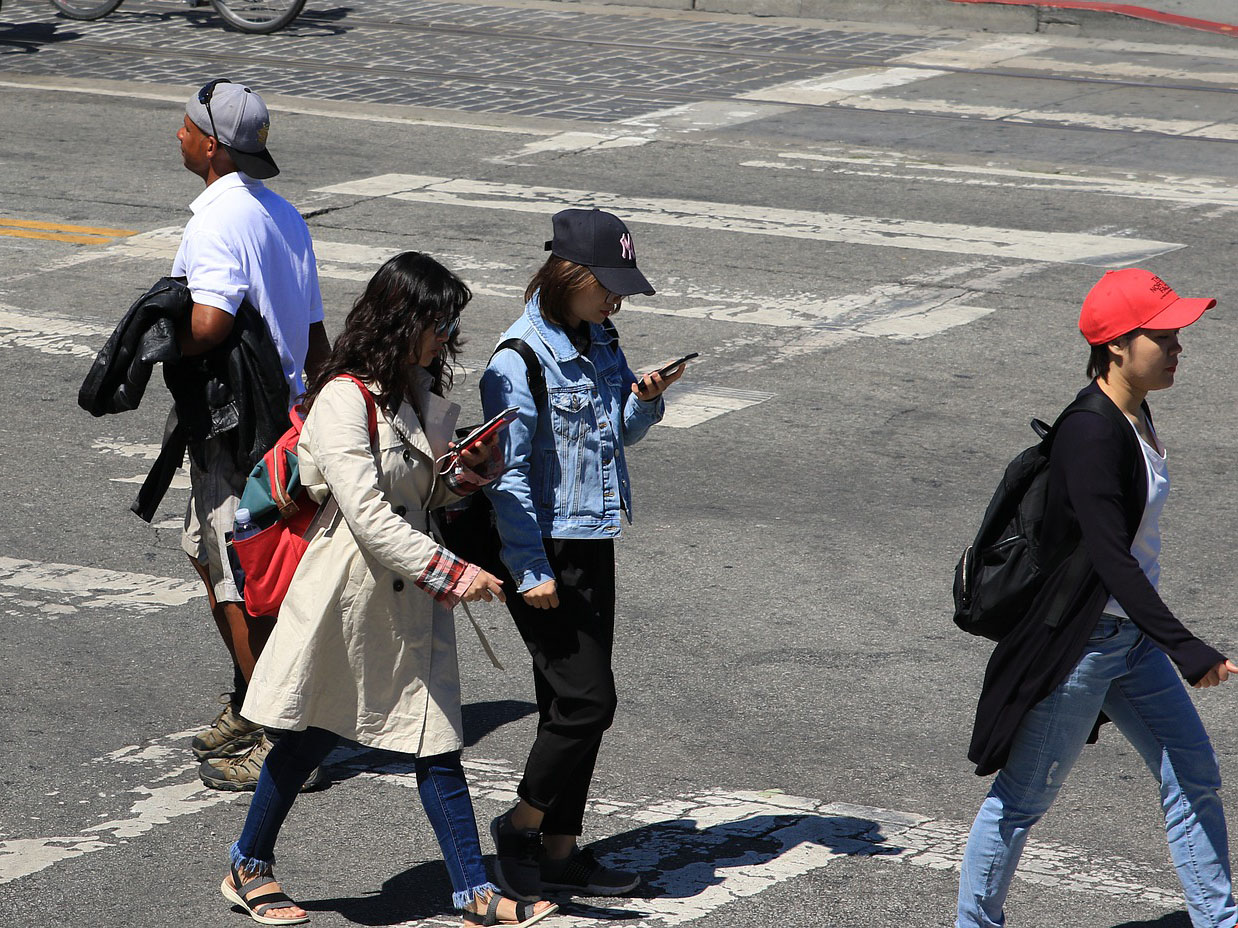You’ve no doubt seen it: Someone crosses a busy Toronto street with their head down, hands busily texting or swiping away on their smartphone. Call them “distracted walkers”, “smartphone zombies”, or, the scientific term, victims of “inattentive blindness”. But no matter the label, it’s clear that not everyone is putting their best foot forward when crossing city streets, and that serious injuries for distracted pedestrians can be the result.
The big debate is over what can be done about it.
A Toronto Public Health report found that “inattentive” pedestrians were 40% more likely to be seriously injured or killed in a collision with a vehicle than those that were not distracted.
Another new study, which looked at 20 years of emergency room data, found that the number of head and neck injuries associated with negligent cellphone use has increased steadily over that period. The distraction cases included incidents of people tripping and falling causing injury, as well as those involving motor vehicles.
A recent Insurance Institute for Highway Safety study points out that pedestrian fatalities have soared 46% since 2009, with the bulk of them coming in urban or suburban centres. The fact that right around that time, smartphones started gaining in popularity, should not be considered a coincidence.
There have been a number of studies showing that texting while walking seriously impairs an otherwise healthy adult’s ability to respond to their environment. Some of the tests showed “smartphone zombies” completely oblivious to nearby objects like a clown riding a unicycle, or money hanging from tree branches.
In addition to a reduction in perception of their surroundings, people in these texting-and-walking studies were also FOUR times more likely to exhibit an unsafe road crossing behaviour. How does using a phone impair your ability to walk? Biomechanical studies in a lab showed the following:
- Altered body posture and walking movements
- Slower walking speeds
- Decreased steps per minute
- Shorter stride lengths
Although there’s no agreed-upon data yet on the specific correlation between distracted walking and traffic accidents, it’s not a stretch to assume that any number of these behaviours, when conducted crossing or near a busy street, can lead to tragic results.
Drivers Still Bear Responsibility
All that being said, we’re nowhere near a world where drivers of vehicles can be absolved of fault in an accident involving a pedestrian. Far from it. In fact, in these cases causing loss or damage to a person, the Highway Traffic Act’s “reverse onus” clause (Section 193[1]) states that the onus is on the driver of the vehicle to disprove negligence.
Indeed, that same Toronto Public Health report cited earlier found that pedestrians had the right-of-way in 67% of collisions studied between 2008-2012.
However, these cases are complex, and “right-of-way” is not the sole deciding factor. Even if the driver of the car cannot disprove negligence, it is conceivable that a texting pedestrian, who is otherwise crossing lawfully, could be partially to blame for the accident and have their damages reduced accordingly.
Since reckless or distracted drivers are out of your control, keeping your head up and putting the phone down is simply a common-sense means of avoiding becoming one of those statistics.
Zombie Laws
“Distracted Pedestrian” or “smartphone zombie” laws are in place in a few cities around the world, imposing fines on people who cross streets while immersed in their electronic devices. This has stirred up a rousing debate, which has come up on several occasions in Toronto.
In 2017, an Ontario MPP’s proposal for just such a law was shot down. Now, with Toronto mayor John Tory recently updating the city’s Vision Zero road safety plan, the controversy has reared its head once again.
Opponents of these so-called “zombie laws” point out that better road infrastructure, and even more education against distracted, impaired and reckless driving are better targets. In fact, distracted driving is the number one cause of deaths on Ontario’s roads.
If you or a loved one have been seriously injured in a traffic accident of any kind, with so many of the above factors coming into play, it’s imperative that you seek qualified legal help immediately. The experts at Horowitz Injury Law have nearly 35 years of experience with road accidents, and can get you the compensation you deserve. Call 416-925-4100 for a free up-front consultation.
Bottom line, there’s no doubt that regardless of who’s at fault, when it comes to a collision between a pedestrian and a two-thousand-pound mass of moving metal, the party with the greater risk of serious injury is obvious. Don’t be a statistic.
Heads up, phones down. Practice safe texting.




